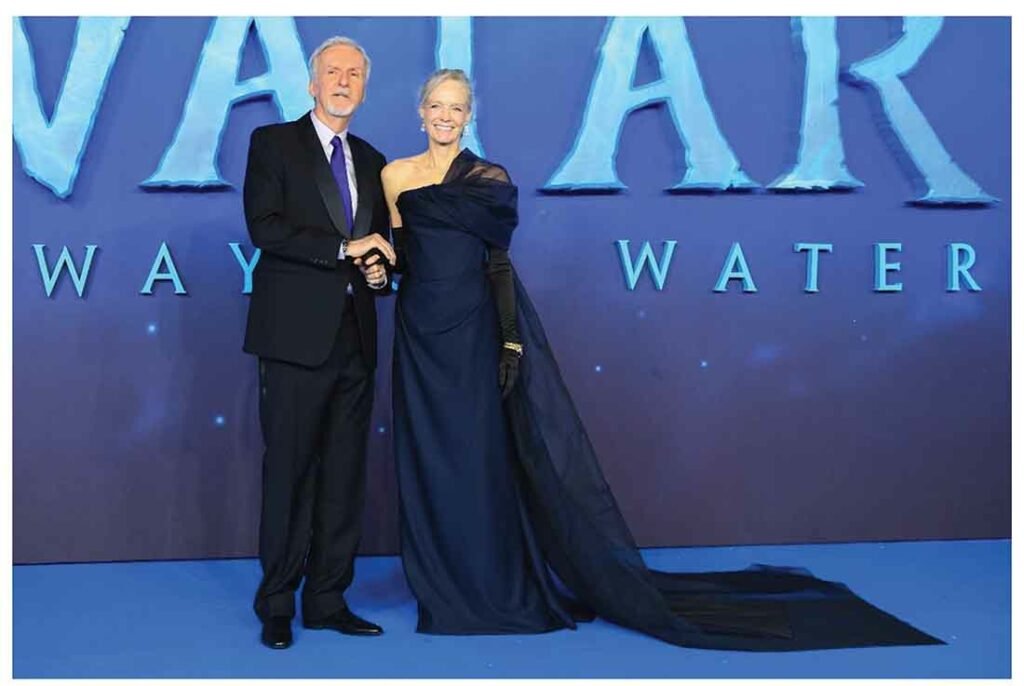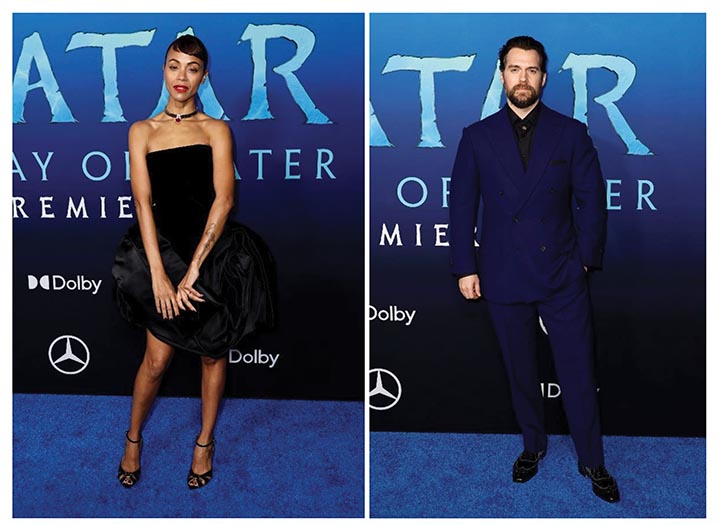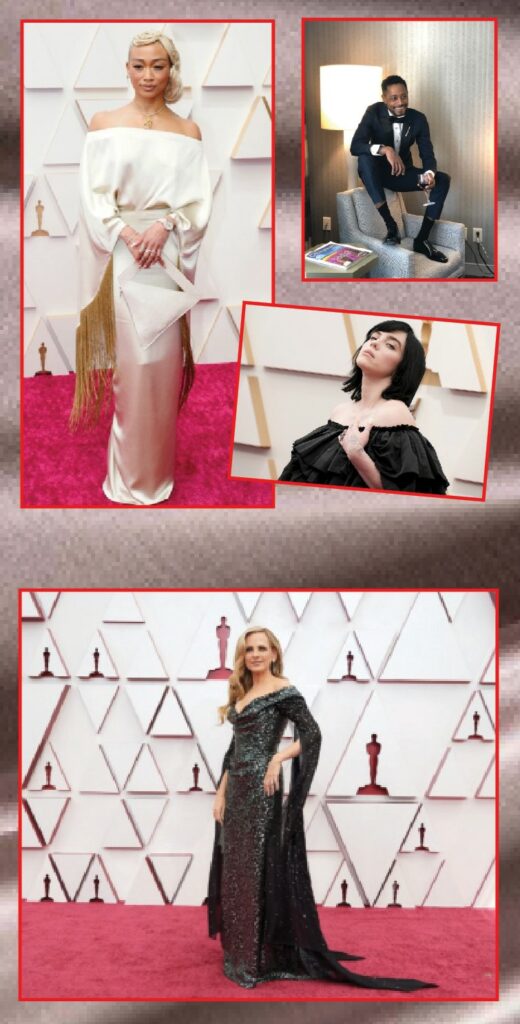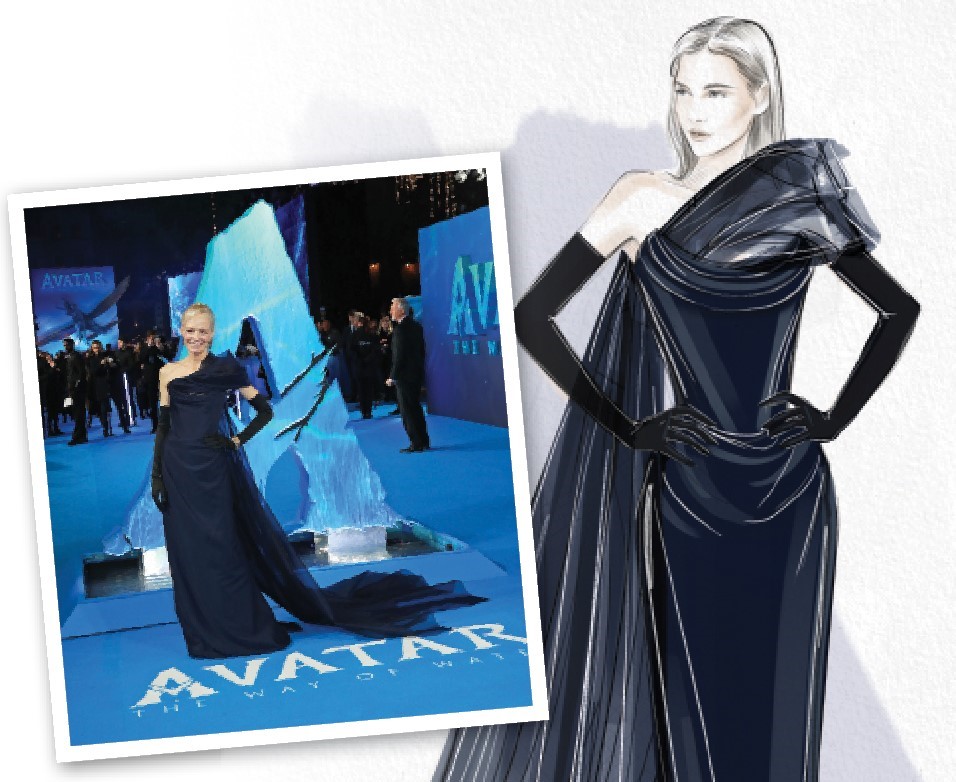Inspires in the Spotlight
AVATAR: The Way of Water Continues the Eco-Aware Saga of the Sully Family, While the Film’s Stars Embrace Eco-Conscious Fashion Beyond the Screen and on the Red Carpet
As the blockbuster sequel AVATAR: The Way of Water inches towards $2 billion in global ticket sales as one of the top producing movies in history, the real story was on the red carpet – at least for the textiles industry. You may or may not know that filmmaker James Cameron and wife Suzy Amis Cameron are a powerhouse when it comes to their dedication to environmental conservation. While he makes a statement on film, she makes hers on red carpets across the world … and beyond.
In 2009, Suzy Amis Cameron founded Red Carpet Green Dress™ — now called RCGD Global, a sustainable fashion campaign showcasing environmentally responsible fashions on the red carpet in partnership with the Oscars®. RCGD Global also co-creates sustainable garments with luxury international fashion brands, and more. This is just one of many of Amis Cameron’s initiatives, but this one clearly shines the spotlight on the importance of social consciousness and eco-positive practices in the apparel industry.
According to earthday.org, much change is needed in the fashion industry if you look at some of the staggering statistics:
- The fashion industry produces 150 billion garments a year and 87% (40 million tons) end up in a landfill where they smolder and pollute the air or an incinerator.
- Only 1% of all discarded clothing is actually recycled.
- The average person today buys 60 percent more items of clothing than they did 15 years ago but keep them for only half as long. The average garment may be worn as few as ten times before disposal.
- The apparel industry is responsible for 4% of greenhouse gas emissions – the same as the countries of Germany, France and the U.K. combined. Unchecked, fashion production would account for 26% of all carbon emissions by 2050.
… And so on.
RCGD Global is working toward solutions to these problems, and the organization uses its platform powered by celebrity influencers to create conversations and awareness to generate change. They want to see a sustainable fashion industry that produces garments with consideration of the environmental and the social impact that they will have throughout the total life cycle.
And to do this, they also believe it will take collaboration across industries.

One such collaboration between RCGD Global and Lenzing is showcased on the AVATAR: The Way of Water red carpet with the display of sustainable high-couture fashion. Lenzing’s flagship product TENCEL™ – the featured textile ingredient – are fibers extracted from sustainably grown wood using a unique closed loop system which recovers and reuses the solvents used, minimizing the environmental impact of production. Unique physical properties lead to their high tenacity profile, efficient moisture management and gentleness to skin. Most TENCEL™ fibers have been certified as biodegradable and compostable under industrial, home, soil, freshwater, and marine conditions, and can fully revert to nature.
The film’s stars supported the effort with their choice of premiere apparel. British actor Henry Cavill wore a double-breasted coat with peak lapel and straight pockets, created by Huntsman using TENCEL™ Lyocell fibers, with a strong waistline and high armhole.
“I decided to support RCGD Global, because they are highlighting yet another way for us all to take a step in protecting the planet and her people. It’s highly unlikely that any of us can change an entire lifestyle in one go, but taking small steps, making small changes especially if done in large numbers can make a difference. Sustainable clothing materials is one of those ways. Just as importantly, sustainability in clothing doesn’t mean a lack of quality. The textiles that Huntsman has provided me are indeed sustainable, while their tailoring remains impeccable – even for a moving target such as me!” Cavill said.
Other stars have recently worked with RCGD Global, including Tati Gabrielle, Billie Eilish and Maggie Baird across to Lakeith Stanfield. They offer different stories and different perspectives to the efforts.
To discuss the RCGD Global/Lenzing collaboration, International Fiber Journal interviewed Harold Weghorst, Global Vice President of Marketing and Branding at Lenzing AG, and Samata Pattinson, CEO of RCGD Global, to share how it all came together. Here is what they had to say.
Never in history has sustainability been more relevant. Collective responsibility means we can’t rely on one end of the industry to save us. We must all do our part.
Samata Pattinson
The Collaboration
International Fiber Journal: How did the joint collaboration between Lenzing and RCGD Global come about?
Harold: RCGD Global (formerly known as Red Carpet Green Dress™) was originally founded by leading environmental advocate Suzy Amis Cameron in response to a lack of ethical choices on the red carpet. Both RCGD Global and Lenzing, a leading global sustainable fiber manufacturer, share a similar vision – we believe high quality and high fashion can be combined with sustainability. Therefore, our partnership just felt like a natural next step for both parties.
IFJ: How long has it been a joint initiative to feature “eco-culture” at the Oscars® and other Red Carpet Events?
Harold: The joint initiative between Lenzing and RCGD Global was carried out under Lenzing’s specialty-fiber brand, TENCEL™, and first began on the red carpet of the Oscars® ceremony in 2020. We will be celebrating our 4th anniversary of the partnership in March 2023. An important point to note is that, in 2022, we extended the initiative beyond the Academy Awards®, to the red-carpet premiere of the recent hit movie AVATAR: The Way of Water.
Aside from red-carpet events, we also invest in empowering next-generation fashion talent through initiatives such as the 2020 and 2021 Global Design Contest, an international design contest that is open to all young and established designers over the age of 21, as well as webinars or seminars targeted to design school students and stylists.
IFJ: What other celebrities are embracing the sustainable fashion trend?
Samata: Every year, since the inception of the campaign, movie stars and filmmakers including Léa Seydoux, Kaitlyn Dever, Marlee Matlin, Tati Gabrielle, Paloma Garcia Lee, Maggie Baird, Elena Andreicheva, along with our very own RCGD Global founder Suzy Amis Cameron, have stunned on the red carpets at the Oscars® in custom-made outfits created with fabrics made of TENCEL™ branded fibers and filament.
In 2021, we were honored to be able to showcase eco-couture on two occasions, thanks to Zoe Saldaña, Henry Cavill, James Cameron and Suzy Amis Cameron, who joined the initiative at the premiere of AVATAR 2: The Way of Water in the UK and Los Angeles.

Designer brands which took part in the creation of these bespoke outfits include Louis Vuitton, Vivienne Westwood, Patrick McDowell, Huntsmen, Laura Basci, HELLESSY and BENEDETTI LIFE.
Harold: After the successful premiere of AVATAR 2: The Way of Water, we are looking to continue our expansion of our partnership to other major red-carpet events.
IFJ: What are the challenges observed in pushing haute couture toward sustainability and how TENCEL™ can help overcome these challenges?
Harold: One of the main challenges is material sourcing. After working on this initiative, it came to light that many designers have no idea where to find sustainable materials. We hope that through our actions, we are not only driving awareness within the industry of the urgent need to reduce fashion waste but also introducing sustainable materials like TENCEL™ fibers to designers – present and future.
To address the challenges of sourcing fabrics, we’ve added a directory on our TENCEL™ for business website which shares where to source it, enabling designers, smaller brand owners, or even fashion students, to connect with mill partners that best fit their fabric or garment needs.
Samata: Haute couture is one of the biggest components of the fashion industry, accounting for billions in annual revenue. Unfortunately, the current production practices used to create haute couture garments can often be quite unsustainable and need to be addressed swiftly. To move haute couture towards a more sustainable model, the biggest challenge lies in changing industry-wide operational processes and finding new materials that meet ethical and environmental standards while still being luxurious and fashionable.
The second challenge is obtaining public acceptance as sustainability has yet to become a mainstream norm in high-end luxury fashion. To overcome these challenges, brands should introduce eco-friendly materials that still maintain luxury and quality often associated with haute couture, create partnerships with eco-friendly suppliers and initiatives, transparently report efforts taken to improve sustainability goals, and engage celebrities who share the same values for a successful transition. With the right tactics, haute couture can reach its full potential as an environmentally friendly industry powerhouse. Another part of that requires elevating the experience side of luxury and recognizes that true luxury is community, value systems beyond the monetary and positive legacy building.
IFJ: How has this initiative advanced the awareness in Hollywood (and followers of Hollywood trends) on the importance of being fashionable, but also aware of the impact fashion waste has on the environment?
Samata: We work to really straddle four core value systems. Specifically, this means collaborating with respected and mainstream platforms to foster sustainable conversations and action, developing accessible sustainable design solutions which create real effective change, being part of creating a more socially fair, equitable and representative industry, and helping to find language to create change.
Commitment to collaboration is a crucial pillar of Lenzing’s sustainability and business strategy. We have worked closely with our partners to understand the needs and challenges the industry faces, so we can unite the industry and set a standard for true sustainability.
Harold Weghorst

The Technology
IFJ: What is the technology and science behind TENCEL™ that makes it eco-friendly?
Harold: TENCEL™ fibers are wood-based cellulose fibers. The raw material comes from renewable sources and is produced with minimal environmental impact. For example, TENCEL™ Lyocell fibers are produced in a closed-loop process with high resource efficiency and low ecological impact, where process water is recycled and more than 99% of the solvent is reused. Our TENCEL™ LUXE lyocell filament yarns, also recognized as vegan silk, are also produced in a closed-loop process. TENCEL™ modal fibers, on the other hand, are produced using highly resource efficient technology. Thanks to their botanic origin, TENCEL™ branded fibers and filaments are fully biodegradable and compostable.
IFJ: What challenges had to be overcome in development, and how has it evolved over its years of being in the marketplace?
Harold: At Lenzing, we continue to innovate and enhance our fiber offerings through new technologies. Since the launch of the TENCEL™ brand 30 years ago, we have introduced technologies like REFRIBRA™ as a way to produce TENCEL™ Lyocell fibers with circularity in mind. The invention of the REFRIBRA™ technology enables us to upcycle cotton scraps from garment production into new virgin TENCEL™ Lyocell fibers by combining them with wood pulp. In 2021, we launched the new TENCEL™ Limited Edition initiative, where we reinvented TENCEL™ fibers using unconventional sustainable raw materials, like orange peel.
IFJ: What is the advantage of TENCEL™ being applied to many uses from fashion to luxe to home goods?
Harold: In addition to its strong sustainability profile, TENCEL™ fibers are known to have a luxurious sheen, are naturally soft, and breathable, providing the wearer with long-lasting comfort. When used in home products, functional benefits such as thermal regulation, moisture absorption, and proofing against bacteria and dust mite growth are what make TENCEL™ fibers much more desirable.
TENCEL™ LUXE Lyocell filament is highly versatile and can be woven into a smooth, lightweight fabric with a liquid-like drape and a highly flattering silhouette, making it a great botanic alternative to silk.
IFJ: How does Lenzing partner with brands to bring these products to market, especially from a technical application perspective?
Harold: We are honored to have worked with numerous fashion and home textile brands, from global labels to local heroes, each joining TENCEL™ in their journey to sustainability. Many of these, in addition to using our fibers in their collection, actively promote the sustainability profile, functional benefits and innovative technologies of TENCEL™ fibers in their external communications.
These cobranding efforts not only help raise the general awareness of TENCEL™ fibers but also educate consumers and industry players about the immense benefits our fibers offer.
IFJ: TENCEL™ is in the news celebrating its 30-year-anniversary. How has it remained a steady force in textiles all these years?
Harold: We have remained a steady force within the textile industry by working closely with partners along the value chain, such as RCGD Global, to drive positive change. We know that sustainability in the industry is an impossible task to progress alone, and complex sustainability challenges require industry-wide collaboration. Commitment to collaboration is a crucial pillar of Lenzing’s sustainability and business strategy, and in our three decades as a fiber producer growing into an increasingly front-facing player, we have worked closely with our partners to understand the needs and challenges the industry faces, so we can unite the industry and set a standard for true sustainability.
“It’s highly unlikely that any of us can change an entire lifestyle in one go, but taking small steps, making small changes especially if done in large numbers can make a difference. Sustainable clothing materials is one of those ways.”
Henry Cavill
The Mission Possible
IFJ: From your perspective, what is the mission and importance of RCGD Global?
Samata: RCGD Global is a women-led global change-making organization bringing environmental and social sustainability to the forefront of conversation and action within the global apparel and design industry. From our Red Carpet Green Dress™ initiative in partnership with the Annual Academy Awards® collaborating with global and small independent brands, across to partnerships delivering sustainable design solutions, we challenge the current linear business model by placing a focus on people-centric values and intelligent design systems. Our educational work with youth and emerging design community includes knowledge-transfer platforms, workshops, internships and work experience, and design contest initiatives. Our R&D division innovates circular design solutions including regenerative materials.
IFJ: How has this mission grown over the years to inspire celebrities and students to be eco-aware in fashion?
Samata: We started as a design contest for emerging designers to enter. We have since grown in an organic way by reacting and also predicting how the space is developing. We went from focusing on design as a source of inspiration through a contest to really seeing how academic thinking, education, collaborations, and much more can help raise awareness and bring more people in. That is our passion, to include rather than exclude and in that way inspire shifts in mindsets.
IFJ: Why is the Red Carpet the place to launch awareness campaigns and promote sustainability?
Samata: It is one place but not the only place. The incredible platform our Oscars® campaign gives us helps us champions brands that are going the extra mile to do good allowing us to reach a global audience in one night – quite literally with one dress (or tuxedo). Through the red carpet, our campaign reaches millions in nearly 100 countries.
Also important, the campaign works with a very global range of talent to remain inspiring and relevant. We make sure the work we do and the brands we support reflect the ever-changing world around us as accurately as possible – to date working with over 21 countries. Through these actions, we can spread more awareness and continue creating positive, accelerated change. We have been promoting this change for over a decade now, but never in history has sustainability been more relevant. Still, collective responsibility means we can’t rely on one end of the industry to save us. We must all do our part.


